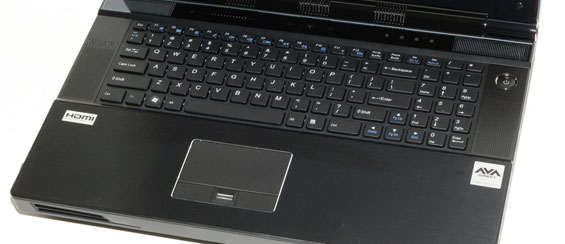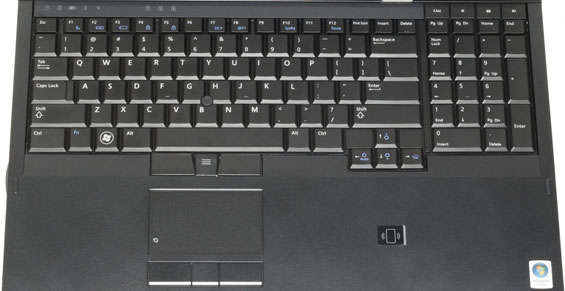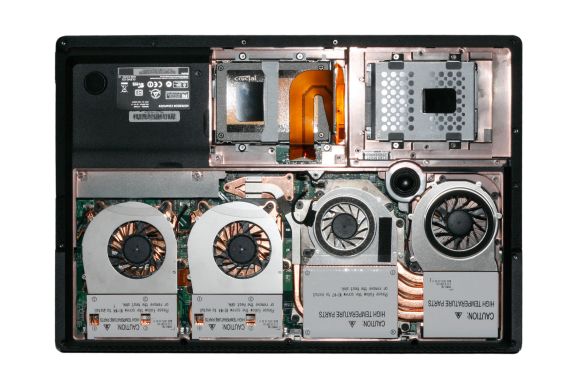AVADirect Clevo X7200: Six Cores, SSD RAID, and GTX 480M SLI Yields World's Fastest DTR Notebook
by Jarred Walton on October 7, 2010 12:30 AM ESTClevo X7200: Digging Deeper
As we mentioned, this is the nicest looking Clevo unit we've ever seen. It's still big and heavy, but the aluminum panels in place of glossy plastic are greatly appreciated. It's unfortunate that Clevo continues to use a glossy plastic bezel around the LCD—the one place where you're practically guaranteed to get fingerprints whenever you open the system. Even with a few minor blemishes, though, the X7200 is a clear improvement on previous designs.
The LCD boasts a good contrast ratio but it's not particularly bright. We've seen this same LCD in the ASUS G73Jh, as well as the Clevo W880CU. It uses CCFL backlighting and produces good colors overall, but still falls far short of a good desktop LCD. Clevo lists a 120Hz 1080p 3D LCD as an optional upgrade, though at present that's missing from the AVADirect configurator. We'd really like to see what the 120Hz panel is like, because hopefully it can boost the brightness without sacrificing contrast, and 120Hz signals are nice even if you never run a 3D movie or game. Considering all the other features, we would have liked to see keyboard backlighting, and the blue glowing strip in the touchpad seems less important than glowing keys, particularly if you're ever interested in attending a LAN party.
With all the other improvements, it's a crying shame that Clevo still can't be bothered to fix their lamentable keyboard layout. Seriously, look at the number keypad and cursor keys.

The decimal point, plus, and minus keys are in a location that differs from every full size keyboard on the planet, and it's not as if they don't have enough room to fix the layout. There's easily an inch and a half on the right and left sides of the keyboard that could be put to good use with a better layout. Once again Clevo trots out the same old tired keyboard design, with [Fn + cursor] key combinations required to use the Home, End, PgUp, and PgDn keys—or you could disable numlock and find those keys on the number keypad. Simply put, neither solution is remotely acceptable in a high-end desktop replacement with plenty of room. I'm not sure how to get through to Clevo on this one, but your keyboard layout is garbage and needs a change! Here's a simple solution, taken from Dell's Precision M6500:

See how easy it would be to fit that into the 17" and larger Clevo designs? See how Dell manages to put a normal 10-key in there, with cursor keys slightly offset so you don't accidentally hit the right arrow when you're looking for the zero, or the enter key when you're going for the decimal point? I don't know if there are a bunch of Clevo users out there that love the current layout, but for me it's a low point on every Clevo based laptop I test. People are paying well over two grand for these systems, and we're talking about a change that should cost a small amount of "R&D" at best. Granted, Clevo has keyboard layouts for quite a few languages, but I'm betting they all have the same layout issues as the US version.
Dustin went off on the Acer/Gateway keyboard and the "floating island" keys a couple weeks back, but for my money I'd say this is the more egregious sin. Gateway and Acer laptops are at least value propositions, but this is a bucket load of cash for something just as bad. If you never use the 10-key or the Home/End and PgUp/PgDn keys, the keyboard action is fine and represents typical chiclet designs, but on a mobile workstation I'd want to use both the 10-key and the page navigation keys. (I do miss the context-menu key on the Dell, however... it's something I use but I'm not sure anyone else does. That's easy enough to correct, of course.)
Incidentally, I did a 10-key typing test just to see how bad the layout affects me. The verdict: I key in numbers (with decimal points and mathematical operators) three times as slow and I'm about five times more likely to make an error! I could probably improve after a while, but I can never see myself using this 10-key at anything approaching a normal speed—especially if I continue to use regular desktop keyboards on a regular basis. Thankfully at least there's not a bunch of flex in the keyboard to really push me over the edge, but for a high-end notebook the keyboard is at best merely average. But enough about the keyboard, let's look at the internals.
Getting at the insides of the X7200 isn't too hard, though there are four different areas you can access. For the main CPU and GPU area, you remove the single large access plate on the bottom. That gets you a nice view of the four gigantic blower fans and heatsinks for the CPU, chipset, and GPUs. A smaller plate lets you get at the double HDD bay (occupied by the two C300 SSDs in our system), and the battery needs to come out if you want to get at the third hard drive slot. As for the memory, to upgrade RAM you'll need to remove the keyboard—a bit more of a pain in the rear than some of the other laptops.
What we'd really like to see is the ability to upgrade GPUs to newer designs down the road. Judging by Eurocom's Phantom 2.0, the X7200 can support everything from CrossFire HD 5870 to GTX 460M, 470M, and 480M SLI. I can't imagine power budgets on future notebooks getting much bigger than 100W per GPU, and with a hex-core "extreme" desktop CPU the graphics are certainly going to be the bottleneck in gaming. Unfortunately, longevity simply isn't a strong point for desktop replacements. The X7200 may be a barnburner for notebook performance right now, but inevitably we're going to see "GTX 580M SLI" or "HD 6870 CrossFire" in the next year or so that will surpass the current setup. If you're willing to drop four large on a gaming notebook, having the ability to upgrade to newer graphics chips for a couple years would be great. For now, we wouldn't count on any GPU upgrades.

















38 Comments
View All Comments
Wolfpup - Wednesday, October 13, 2010 - link
This article seems to imply that the G73jh/jw uses florescent backlighting, but it's LED, right?Wolfpup - Thursday, October 14, 2010 - link
Okay, I've been told the G73jh/w are LED backlit, so that's good.JarredWalton - Saturday, October 16, 2010 - link
The displays in all of these are the HannStar HSD173PUW1. To my eyes, it *looks* more like CCFL than LED, and the brightness levels are pretty weak (maximum of 180nits or so). I can't find any concrete details, but everyone else appears to thing it's LED backlighting so I might be wrong.JarredWalton - Saturday, October 16, 2010 - link
Update: notice the ASUS page:http://rog.asus.com/Product.aspx?PId=32#product_ta...
They simply list it as "17.3" Full HD (1920x1080)/HD+ (1600x900) Color-Shine (Glare-type)", which would be odd for an LED backlit display. Especially when the G60Vx explicitly states LED backlighting:
http://rog.asus.com/Product.aspx?PId=30#product_ta...
mikeev - Wednesday, October 20, 2010 - link
Why do you guys never mention the fingerprint sensors on these laptops? I know they're not the most exciting things in the world, but they're pretty nice feature additions. Beats typing in your password every time.Gonemad - Thursday, November 4, 2010 - link
Now, about the power brick... did Furmark just cause a 'thermal runaway' back there? 410W, are you kidding? That's nearly 40% overload on the nominal brick power, no wonder it cried for mommy and called it a day after some time of testing.It raises a couple of questions:
1) In the review itself, it is mentioned about other notebook that would actually drain the batteries when the PSU is topped-out. Clevo should go visit the same idea, now knowing that some extreme usage can compromise the PSU. Call it a 'feature'. Call it 'Overdrive' or whatever; it lets you have all the juice you need even overloading the PSU, but it detects the condition, light up a yellow warning light, and lets you do it for, say, 30 mins before cutting BACK, not OUT, the power drain. It doesn´t shut down, not completely. Again, the battery being used as a VOLTAGE STABILIZER looks good.
Well, then again, the benchmark was a deliberate attempt to overload the thing.
2) Aftermarket an even LARGER power brick, this time full-fledged 500W PSU at 4 pounds or higher. Considering everything else, it is not so preposterous.
3) If Anand dumped the original PSU, but kept it going on a LARGER DC source (a good and nice desktop PSU ought do it), how far would it go? Would something else drop out?
Classic Rock - Sunday, November 7, 2010 - link
I have read in the X7200 User forums that Clevo has offered a "Solution" of combining two PSU's together with some sort of adapter. There wasn't a lot of detail where I read it though. Does anyone know anything else about this? Does anyone know if it is possible to get an aftermarket PSU for this rig?Classic Rock - Sunday, November 7, 2010 - link
Adding to my previous post:http://www.nextcomputing.com/products/mobile-works...